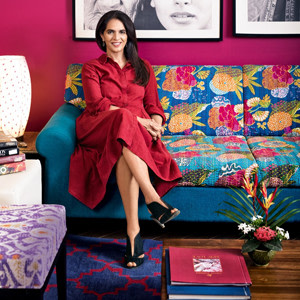Traditional Jewelleries of India
India has a rich and diverse cultural heritage, and its traditional jewellery is a testament to its beauty and complexity. Traditional Indian jewellery comes in a variety of styles and designs, reflecting the country's regional and ethnic diversity. Some of the most popular types of Indian jewellery include Kundan, Polki, Meenakari, Temple jewellery, and Jadau. Kundan jewellery, which originated in Rajasthan, is characterized by intricate designs crafted using gold, gems, and precious stones. Polki jewellery is another type of traditional jewellery that dates back to the Mughal era and is known for its uncut diamonds set in gold. Meenakari jewellery, which is native to Jaipur, is famous for its intricate enamelling work that involves decorating metal surfaces with colourful designs. Temple jewellery is commonly worn by South Indian brides and features intricate designs inspired by temple architecture. Jadau jewellery is a type of jewellery made using gold and uncut diamonds and is popular in Rajasthan and Gujarat. Traditional Indian jewellery not only adds a touch of glamour to any outfit but also serves as an important cultural symbol, representing India's rich and vibrant heritage.Serpech
Serpech is a type of traditional Indian jewellery that originated in the northern regions of the country, particularly in the state of Rajasthan. It is typically worn by men on special occasions such as weddings and other formal events. Serpech is a type of headgear that is adorned with intricate designs made of gold, gems, and precious stones. The design of a serpech typically incorporates elements of nature, such as flowers, leaves, and birds, as well as cultural motifs and symbols. The craftsmanship involved in making a serpech is highly skilled, with intricate details and delicate workmanship. Serpech jewellery is a symbol of status and prestige, and is often passed down as a family heirloom from one generation to the next. It is a testament to India's rich cultural heritage and the craftsmanship of its artisans. Serpech is typically made of diamonds and emarald and it is worn by men on their turban. Elaborate Jaipur enamel work is done on it. Even the queens of Mugal used a similar type of head ornament.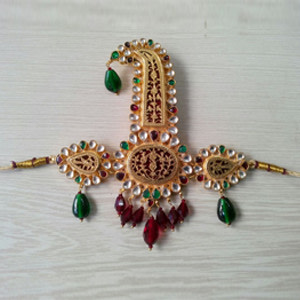 Serpech
Serpech 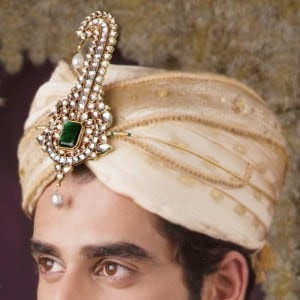 Serpech
Serpech Kada (Kangan)
There can be two classifications of Kada, one which is a circular thick bangle made out of iron, meant for religious purpose, and the second is any thick bangle made of precious or semi-precious metals and decorated with adornments, meant for more celebratory occasions and events.The female wear this ornament and it is named Kangan. One style of this is made of a hollow piece each had two designs at the end either twin parrot elephant or peacock. Kada worn by men is carved but not engraved.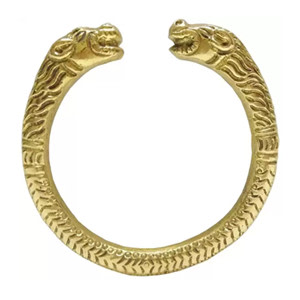 Kada
Kada 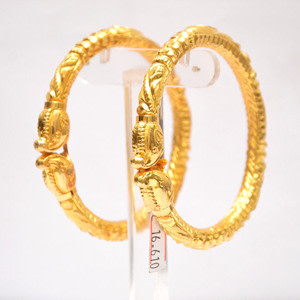 Kangan
Kangan Nath or Nathini
Nath is a nose ornament which is engraved with clusters or single diamond, pearl with foundation gold or silver. In some parts it is a symbol of married women. Another form of Nathini is a larger size ring which is exposed outside and it is held with the help of chain which is attracted to the hair with the help of a hook. This is known to be one of the best art of Maharasthra and is rarely used. Nath
Nath 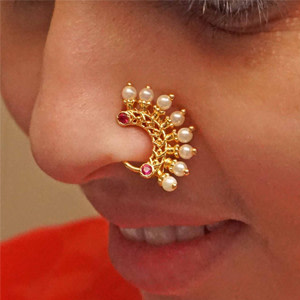 Peshvai Collection Nath
Peshvai Collection Nath 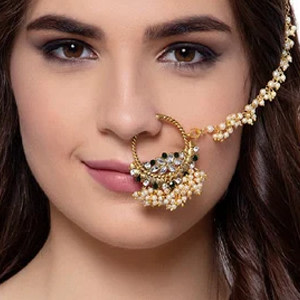 Nathini
Nathini Oodiyanam
Oodiyanam, also known as waist belt or Kamarband in Hindi, is a type of traditional Indian jewellery worn by women in the southern states of India, particularly in Tamil Nadu and Kerala. It is a waist ornament that is typically made of gold, silver and embellished with intricate designs and precious stones such as diamonds, emeralds, and rubies. The oodiyanam is usually worn with traditional silk sarees and is considered an essential part of a South Indian bride's wedding trousseau. It not only adds to the beauty of the saree but also serves as a symbol of status and wealth. The design of the oodiyanam is usually inspired by nature, with intricate patterns and motifs depicting flowers, leaves, and vines. It is a testament to the exquisite craftsmanship of Indian jewellery makers and represents India's rich cultural heritage. It is said that using this ornament regularly, the women maintain the waist even after several deliveries.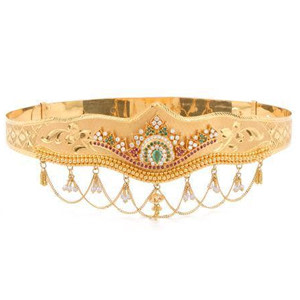 Oodiyanam
Oodiyanam Karan Phool Jumka
Karn Phool Jhumka jewellery, originating from Rajasthan, is a popular traditional Indian accessory among women from various regions, including North India, Maharashtra, and Gujarat. The Hindi translation of "Karn Phool" is "flower of the ear," and the jewellery is designed to hang from the earlobes. Jhumkas are typically made of gold or silver and decorated with intricate designs, such as traditional Indian motifs like paisleys and florals, and small beads. They also commonly feature a tiny bell that creates a tinkling sound as the wearer moves. This jewellery represents feminine grace and elegance and pairs well with traditional Indian outfits like Sarees and Lehengas. The jhumka style of jewellery has been popular for centuries, dating back to the Mughal period. The jhumka features a chain and a large floral stud embellished with diamonds and rubies. It is supported by two strands of pearls and attached to the hair with a hook to reduce weight.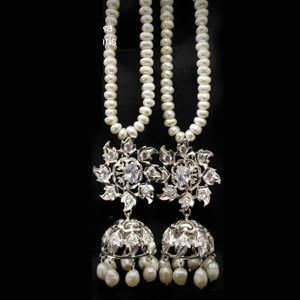 Karan Phool Jumka
Karan Phool Jumka Hathpool
Hath Phool, also referred to as "hand flowers," is a popular traditional Indian jewellery among women across various regions. It is a bracelet and ring combination worn on the back of the hand, connected by delicate chains or strings. The Hath Phool is typically crafted with intricate designs using precious metals like gold, silver, and adorned with precious stones such as diamonds, emeralds, and rubies. It's design is often inspired by nature, with floral and leaf motifs, and may also feature traditional Indian symbols and patterns. This jewellery is often worn during special events such as weddings and festivals, adding elegance and grace to the outfit and representing traditional Indian beauty and culture. The skill and artistry of Indian artisans are showcased in the delicate craftsmanship of this jewellery. Originating from Rajasthan, the Hath Phool is a floral design ornament that connects to five different rings on each finger. The finger parts are adorned with stones, and the reverse side is intricately carved with enamel, with the setting known as Kunthan. Some people even decorate their hands with Henna beneath or under the Hath Phool.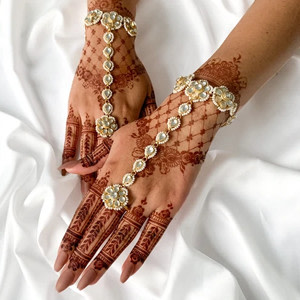 Hathpool
Hathpool 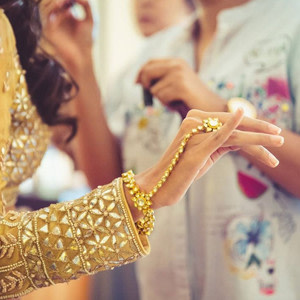 Hathpool
Hathpool 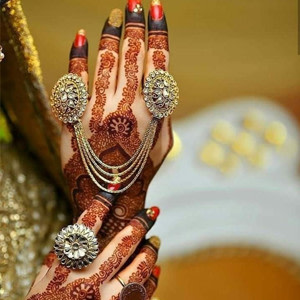 Hathpool
Hathpool Jadanagam
Its origin is from South India which means serpent (Tamilnadu). It is worn by bricks to decorate hair andhas two pieces. The centre piece consists of and moon and it is surrounded by several cobras head. Sun andmoon is the the symbol of glory and serpent is the symbol of power. The sun and moon was stuck with rubiesand diamonds. Several supplimentary ornaments are used with this to enhance the beauty of this. It is alsoused by devadasi or temple dancers, who consider themselves as God's bride. This traditional ornament is continues even now in Bharathanayam costume where serpant head is substituted by flowers. Jadanagam
Jadanagam  Jadanagam
Jadanagam Paizab
Paizab is a leg ornament that originated from Hyderabad. It is a thin base chain with several connecting chains, which creates a board effect. This jewellery is typically made of gold or silver and is adorned with precious stones or engravings, known as Kunthan settings. Paizab is a type of traditional Indian jewellery that is popular among women in various regions of India and is often an essential part of Indian bridal jewellery. This jewellery is commonly worn with traditional Indian outfits such as sarees, lehengas, and salwar kameez, and it adds an element of elegance and charm to any outfit.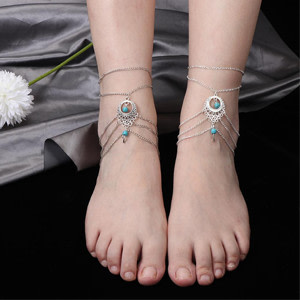 Paizab
Paizab  Paizab
Paizab Vanki
Vanki is a traditional Indian armlet that originated in South India. It is an ornament worn on the upper arm similar to that of a coiled serpant. It is typically made of gold or silver with diamonds, ruby, emrald and other precious stones with intricate designs. The ornament is used primarily during weddings, particularly by brides in South India. The word "Vanki" is derived from the Tamil language and means "bangle for the upper arm." The design of Vanki includes motifs inspired by nature, such as flowers, leaves, and peacocks, with delicate craftsmanship and often decorated with precious stones like diamonds, rubies, and emeralds. Lower portions of the Vanki may have a parrot, leading up to the top. The shape of the Vanki is such that it is fixed over the upper arm without any strap, giving it an elegant look.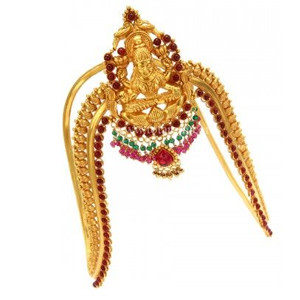 Vanki
Vanki 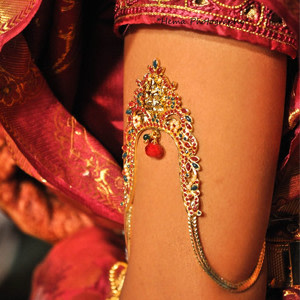 Vanki
Vanki Linga Padakka Muthu Malai
It is a neck ornament made of two strands of pearls joined together, with a pendant in the shape of a Sivalinga made of emerald and gold. The linga is joined on either side by a peacock, and there is a hanging lotus motif at the center. Brides wear it during their wedding, and it indicates the status of women. It was believed that pearls prevented misfortunes, and the pendant was often engraved with words. This ornament was originated in Tamilnadu.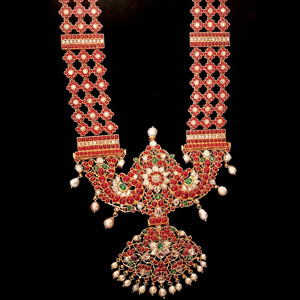 Linga Padakka Muthu Malai
Linga Padakka Muthu Malai Chandrahar
Chandrahar is a traditional Bengali necklace design that derives its name from the Hindi words "Chandra," meaning "Moon," and "Haar," meaning "Necklace." It is made with a layer of chains consisting of tiny gold balls. Bengal has always been famous for its unique and intricate jewelry designs. This ornament is also used in another form on the waist and consists of a series of tiny balls held together in a criss-cross shape with gold wire. It has a long pendant with a flower motif and small flowers on either side of the gold chain.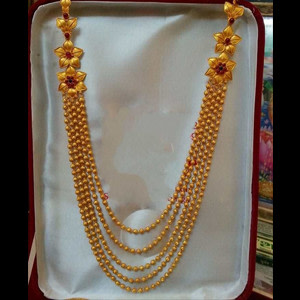 Chandrahar
Chandrahar 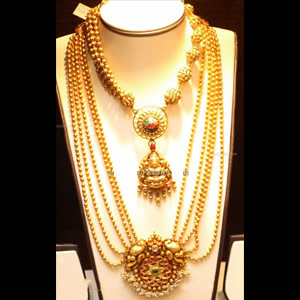 Chandrahar
Chandrahar Shinka
This is a head ornament that originated in Gujarat and is made of gold. It is an exquisite piece held in place by the unusual method of gold hooks attached to the hair. The ornament consists of a series of heavy gold chains held by flat metal strips with carved traditional motifs of peacocks. The peacock symbolizes beauty and grace and is studded with sapphires and emeralds, and sometimes rubies are used. Little golden belts with clusters of pearls hang from the center, enhancing the beauty of the ornament. It is typically used during festivals and wedding occasions.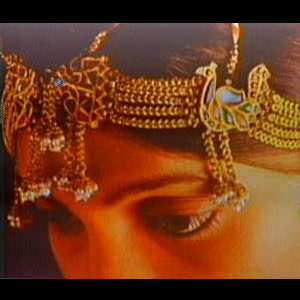 Shinka
Shinka Please leave your comments, we do love it!
Most Viewed Articles
Hey, we have amazing content on the latest Fashion, Trends, Style & Creative Arts, and now it's absolutely FREE for you.All you have to do, is just...We always respect your privacy!
Login / Sign-up
